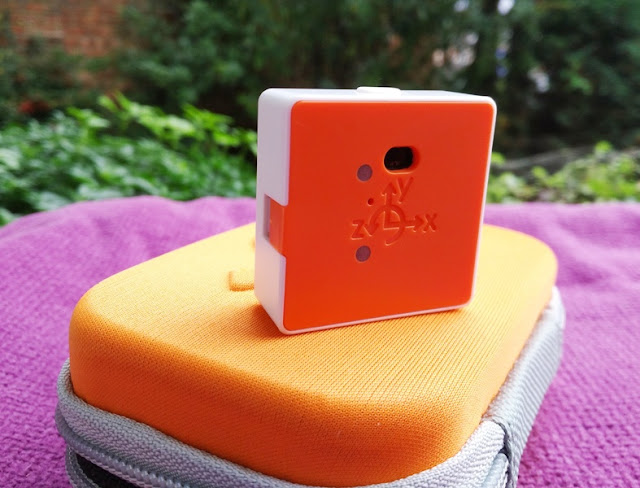

The PocketLab Voyager has an eye-catching orange/white color scheme with three sensors visibly located on the front, which include the infrared rangefinder, light sensor and humidity sensor. The front of the Voyager has the PocketLab logo embedded with the XYZ axis for sensor orientation on the graph. Y (blue), X (red) and Z (green).

back view
Operating the Voyager is easy. Short press the white button and the Voyager powers on automatically broadcasting the Bluetooth pairing signal (LED flashes red and green quickly). To power off the Voyager, you hold down the white button again and let go when the LED shows solid red.

multifunctional button
PocketLab Voyager can read up to 30,000 measurements thanks to ten integrated wireless sensors which stream data instantly to a smartphone, tablet or desktop computer via Bluetooth 4.0 connection, which has a range of up to 250 feet.
micro USB port
The built-in 240 mAh Li-Poly battery is rechargeable via micro USB cable and lasts between 8 hours (in wireless high power mode) and 12 hours (in low power mode). When the PocketLab Voyager runs low on battery, the LED flashes red three times every five seconds.
Test 1: Angular Velocity of USB Fan

temperature probe jack
You can carry out all sort of experiments that have never been done before as you can easily mount or attach the PocketLab Voyager to anything thanks to the included silicone case. With a STEM-based curriculum, the PocketLab Voyager is a nifty tool to have at hand when studying science, technology, engineering and mathematics (STEM).
loop inserts on the back and side of the silicone case for attachment





As mentioned earlier, PocketLab Voyager has built-in a total of 10 sensor, including an accelerometer, gyroscope, magnetometer, barometric pressure, light sensor, altitude sensor, temperature sensor and infrared range sensor. PocketLab Voyager also comes with an external probe that plugs into the unit for measuring the internal temperature of things.

The internal temperature sensor is high precision and has a range from -40 degrees to 85 degrees with a 16-bit resolution, which gives a temperature resolution of 0.01 C (0.02 F) and absolute accuracy of 0.5 C (0.9 F). The temperature probe has a range from -40 to 105 C (-40 - 221 F) with a 10-bit resolution, which gives a temperature resolution of 0.2 C (0.4 F)and absolute accuracy of 0.5 C (0.9 F).





Voyager's humidity sensor measures relative humidity in the air in a range from 0 to 100% RH with a resolution of 0.02 %RH and accuracy of 3% , meaning the humidity sensor is able to sense and report both moisture and air temperature.


The PocketLab Voyager pretty much works with any wireless device (including Chromebooks) that was built with Bluetooth 4.0, Devices that work 100% with the Voyager include Samsung Galaxy S4, Note 2, Galaxy S7, Nexus 7 Tablet and Archos 50e. As far as computers, the Voyager also works with Mac OSX computers and Windows computers (aside from Windows 10, which is not yet compatible).

The PocketLab mobile app connects easily to a mobile device. Simply turn on Bluetooth on your phone and power on the device; the PocketLab Voyager automatically pairs to the app. The PocketLab app dashboard is clearly laid out and easy to use




The symbol next to the camera button is the Graph button, which allows you to graph up to 2 sensor readings at the same time.

The third symbol from the left is the Acceleration button for changing the acceleration unit from metre per second squared (m/s2) to gravity (g).



It's also worth mentioning that PocketLab has another app that you can download, called VelocityLab, which is specifically designed to measure the position, velocity and acceleration of a rolling object.













0 comments